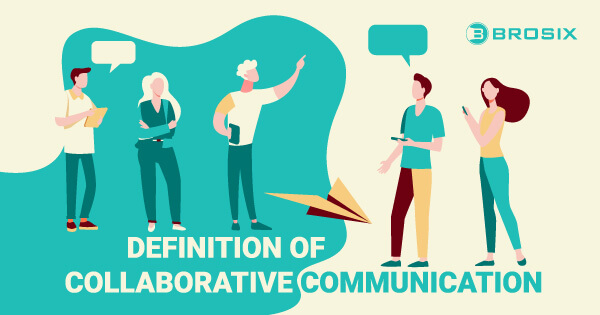In the modern workplace, communication and collaboration are mandatory for business success and progress.
Today’s business environment is often riddled with challenges and obstacles that collaborative communication can help to overcome.
A collaborative workspace is a mix of resources and ways of operating a business that helps people within a team work towards a common end goal.
Communication is the thread that holds these cooperative teams together.
Additionally, collaborative communication fosters creativity, helps people exchange ideas, and closes a communication gap that would otherwise be harmful to the organization.
In this article, we’re going to explore what collaborative communication is, why it’s important in the workspace, and the essential components organizations need to implement it successfully.
1.The definition of collaborative communication
The future of business entails creativity, innovation and the potential to solve complex and sophisticated problems.
If a business already has the capacity to incorporate these critical factors into its overall strategy, then collaborative communication is the icing on the cake.
So, what exactly is collaborative communication?
Collaborative communication is the process of communication in which every person involved matters.
In this communication model, people exchange ideas and information and discuss different topics to reach an end goal together.
Collaborative communication is based on the idea that people want to feel heard, seen and validated.
Whether you’re communicating collaboratively to launch a new feature or create an app, the idea behind it is that everyone is involved and feels they’re contributing to the project.
The concept of collaborative communication involves two key elements:
- Collaboration is the process in which people share common values, ideas and concepts and work together to achieve a goal.
- Communication is the manner in which collaborative teams interact to help reach that goal in an efficient way.
In order to accomplish a common objective, collaborative communication entails fluidly exchanging information and debating different topics as a group.
Collaborative communication promotes openness and free idea-sharing. Therefore, it should be the norm in every business that values its people.
2.Why does collaborative communication matter?
Now that you’ve got an idea of what collaborative communication is, you may be wondering why it’s important to incorporate it in your business strategy.
According to a 2019 study by Dynamic Signal, 80% of the U.S. workforce felt stressed because of ineffective company communication.
The same research showed that 63% of 1,000 U.S. employees intended to leave their job due to poor company communication.
These staggering numbers are clear indicators that communication is a crucial factor in people’s decision to stay with a particular employer.
Good communication reduces uncertainty, eliminates questions and gives clarity and purpose.
While collaborative communication has plenty of benefits for employees, it’s also equally beneficial to organizations.
Well organized teams function more efficiently, thanks to cooperative communication.
The significance of collaborative communication increases with the emergence of collaborative leadership.
Let’s get more practical and see what the benefits of collaborative communication in the workplace are:
2.1. Lowers the rate of employee turnover
According to a Gallup study, 48% of America’s working population are actively looking for job opportunities.
Additionally, organizations and businesses that communicate well with their employees have a 4.5x higher likelihood of keeping their top talent.
These statistics indicate that if employees experience poor communication in the workplace, they become disengaged and lose interest and motivation.
Employees who are disengaged at work are more likely to explore other alternatives, which increases employee turnover.
As a result, it’s critical for managers and leaders to foster an environment where collaboration and good communication are valued if they want to retain their people.
2.2. Reduces ambiguity and confusion
According to Salesforce, 86% of employees and executives consider ineffective collaboration and communication a major cause of failure in business.
Confusion leads to frustration which then leads to conflict. This is where collaborative communication comes into play.
It comes down to communicating clearly about people’s roles and responsibilities to prevent misunderstandings and enable teams to carry out their tasks independently.
2.3. Increases productivity
According to the 2017 Workplace Productivity and Communications Technology Report, 15% of an employee’s overall work time was lost due to ineffective or inefficient communication.
Instead of completing the task at hand, employees spend an excessive amount of time trying to grasp their objectives and responsibilities.
Employee productivity increases when communication is straightforward because they can understand their tasks and duties more easily.
Teams can achieve even greater success when communication is collaborative.
This method helps them connect the missing pieces during task execution, find help when they need it and access resources more easily.
2.4. Brings your team together
Collaborative communication is the foundation of bringing people together and strengthening the relationships between them.
This model helps employees comprehend the company’s direction and their position within it.
It also establishes a link between management and the employees themselves.
If team members are on the same page, they can provide a consistent message about the company.
It also makes them feel that they’re part of a group, which is something all humans desire.
2.5. Boosts morale
Lastly, collaborative communication helps boost employee morale, thus increasing productivity and efficiency.
When employees feel safe to express their ideas without fearing rejection or criticism, their perspective on work is automatically improved.
It gives them confidence that their work is appreciated which ultimately makes them more motivated to do their job better.
3. Creating a culture of collaborative communication
While you may understand its definition and the perks it can bring to businesses, be mindful that collaborative communication doesn’t just happen overnight.
If you want to implement and foster collaborative communication, you need to invest time and effort in creating an environment where such collaboration can flourish.
Let’s explore three best practices for organizations that want to create a culture of collaborative communication.
Identify your team’s strengths and define roles
As an employer, you first have to clearly define the roles and objectives of each team member so that everyone is aware of their expected contribution to any given process.
The organization may become chaotic and confused if your business goals and plan are not properly communicated, which could have negative effects.
Frustration or even conflict can result from ambiguity or a lack of clarity regarding duties and expectations.
You won’t be able to collaborate effectively if you don’t understand how each person’s position differs from the others.
Make sure to clearly identify the team’s goals and strengths, as well as each member’s role and duties in achieving objectives.
Establish a code of conduct
Setting up a code of conduct and a working procedure for all collaborators is also important.
As we’ve demonstrated, strong collaborative teamwork requires mutual respect, acknowledgment and appreciation of each member’s effort.
Make sure to establish a set of rules that makes sense for your business and are in line with your vision, mission and values.
After everyone has this information, ensure your team also follows it.
As an employer, start by giving an example and replicate those values yourself in your day-to-day collaboration and communication.
Business success is always the result of the combined efforts of the teams and departments within that organization.
Therefore, developing a strong collaborative communication plan is essential for reaching that level of success.
Implement a system to manage disagreement
No matter how well your team communicates and collaborates, there will inevitably be mistakes and situations when people disagree with each other.
Not being on the same page all the time is natural, so make sure you have a procedure in place to handle disagreements and resolve conflicts.
Collaborative communication doesn’t encourage blaming culture.
Team members should not feel guilty about making mistakes themselves or harbor resentment towards teammates who make mistakes.
While it’s extremely important that people take responsibility for their actions and acknowledge their mistakes, collaborative communication is not about pinning the guilt on a single individual.
It’s about solving conflicts in an amicable way and finding solutions to make things better moving forward.
4. Essential requirements for collaborative communication in the workplace
Now you know what collaborative communication is, the tremendous benefits it can bring to the table, and how to create a culture to nurture it.
However, it would be naive to think that this is all you need to know to start successfully implementing collaborative communication in your organization.
There are other essential components you need to consider if you want this method to be effective: skills and tools.
Collaborative communication skills
Many businesses assume that employees naturally understand how to collaborate and communicate effectively with their co-workers and managers.
Collaboration and communication, like many other abilities in the workplace, need to be fostered and cultivated.
Let’s see what vital collaborative communication skills you need to encourage your people to develop.
Communication skills
Evidently, good communication skills are essential in a thriving collaborative setting.
A good communication process, however, doesn’t only involve being able to verbalize your thoughts and ideas.
In a collaborative environment, written, verbal and non-verbal communication are the three key components teams need to put forward.
Some people may be naturals at sending eloquent written emails, but have a hard time expressing their ideas verbally in a group of people.
While it may not be very common to possess all three, the good thing is that every skill can be improved through practice.
For instance, if you notice some team members who don’t engage during video calls, extend an olive branch, invite them to participate by asking them questions they’re comfortable with.
This will show them you value their input and encourage them to speak up.
Active listening
Collaboration requires at least two people working together. Therefore, the ability to actively and respectfully listen to others’ opinions is a must.
This skill is crucial in circumstances of disagreement or conflict.
Whatever the scenario, make sure to give the other speaker your full attention while remaining focused and aware of their verbal and nonverbal cues.
Being empathetic and showing respect
Effective collaborators must be able to actively listen and communicate their ideas, as well as respect other participants’ contributions.
You don’t need to agree with every opinion you hear, but it’s vital to show empathy and respect towards your collaborators.
Open-mindedness
The best collaborators understand the value of being receptive to other perspectives.
It’s inevitable that different team members will have various approaches and ideas.
Effective professional collaboration requires the ability to think critically and to be open-minded to alternative viewpoints.
Problem-solving abilities
The ability to overcome any obstacle that may arise is hard to find but not impossible to develop.
Collaborators must be able to spot problems, recognize hurdles and come up with original solutions.
Having the ability to see the full picture also helps with problem-solving. Try to detach yourself from your own objectives and understand that the group’s success comes first.
Only then will you be able to come up with innovative ways to overcome challenges.
Collaborative communication tools
Beyond fostering collaborative communication skills in your team members and leaders, another powerful resource that can help, is adopting the right tools.
With so many options for collaborative working tools on the market, assigning tasks, communicating goals and holding meetings have all become much easier.
Let’s look at some of the best communication tools available:
Brosix
Brosix is an all-in-one secure instant messaging platform that assists organizations in enhancing internal communication and streamlining workflows while ensuring data security and privacy.
Meaningful discussion is made possible through Brosix’s real-time messaging channels, even in remote settings.
Make crystal clear audio and video calls and one-on-one or group chats. This feature hones your internal communication and allows information to flow naturally.
With Brosix’s Text Chats, users can rapidly send and receive text messages within their network contacts while ensuring the security of their conversation.
The Chat Rooms feature helps you designate an area just for discussing a given subject with a specific group of individuals.
Workflows and cooperation are optimized by combining screen sharing with remote desktop control, file transfers, a virtual whiteboard and quick screenshots with communication channels.
Increase team collaboration by using the interactive messaging feature called Whiteboard, where users can visualize ideas and infographics during their conversations.
Slack
Slack is a full-featured collaboration platform that started out as a messaging service for video game creators.
It links with well-known services like Twitter and Dropbox and is an intuitive chat platform.
You can have as many channels or conversations as you like, and they are organized by topic.
Share any type of file (including photos and videos) with colleagues in a second and forget about the time it would take to write an email.
For those occasions when you need to see your coworkers’ faces, it also offers video call features for up to 15 users.
Slack has a user-friendly interface and is very simple to use, even for beginners, thus making this app perfect for small businesses or startups.
Zoom
Zoom doesn’t even need an introduction, most digital nomads have probably used it at least once.
It is a cloud-based solution that includes mobile collaboration, chat, video conferencing and online meetings.
This tool’s main advantages are that it has clear, high-quality audio and video and the option to record calls for later review.
Share your screen with ease, schedule events in just a few seconds, export them to calendars, and invite guests.
With Zoom, you can rest assured that no team member will ever miss an important call.
Trello
The next tool is Trello, which is excellent for project managers and anyone else looking to organize their assignments and complete work swiftly.
Trello enables team members to assign tasks, add descriptions, establish due dates and track each person’s progress.
It is adaptable, simple to use and aesthetically pleasing, which makes this app suitable for a variety of industries, from software project management to web design.
Asana
Asana is a work management software for teams that is available both on the web and mobile devices.
This app assists teams in planning, tracking, and managing their workloads so that they can collaborate on projects with ease.
Create projects, assign tasks to your team members and keep the project’s communication in one place.
Final thoughts
Collaborative communication is here to stay.
If your company cares about its people while also prioritizing growth and progress, then adopting collaborative communication will lead you to success.
While it can be challenging to implement a well-thought-out strategy, with the right resources and tools, anything is possible.
The key is finding the right methods that work best for your people.
Hopefully, this article has given you all the insights you need to start adopting a collaborative approach and open communication in your organization.










